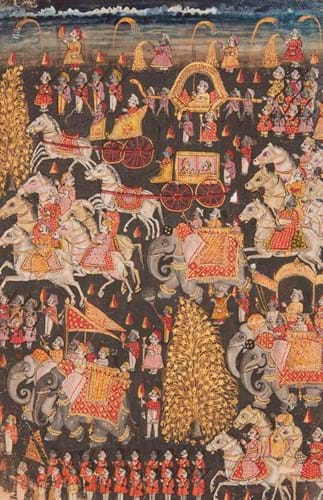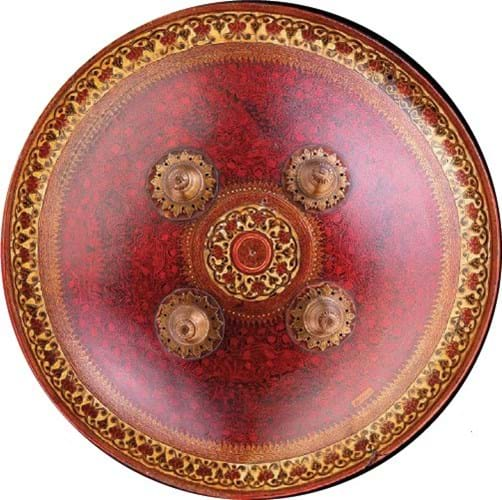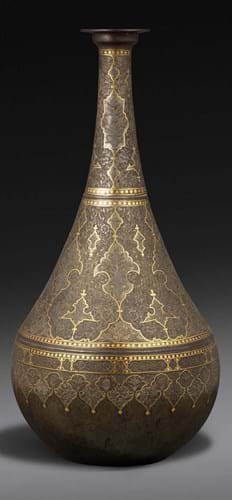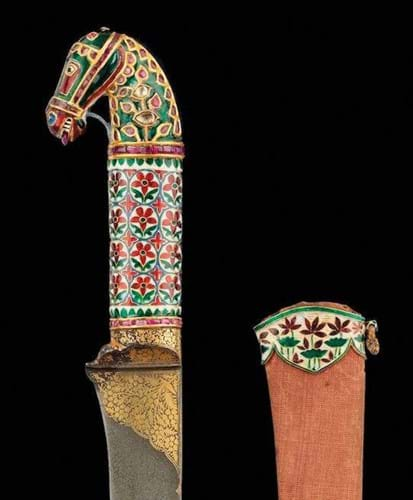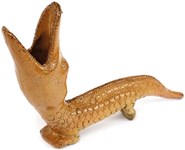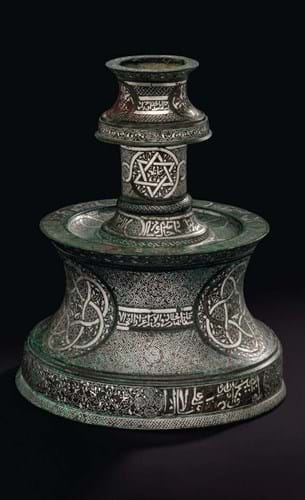
Auction houses
Christie’s - A mid-14th century silver inlaid bronze candlestick from western Iran or Fars
This silver-inlaid cast bronze candlestick (pictured top) belongs to an enigmatic group of similar pieces thought be from mid-14th century western Iran or Fars.
A similar example in the Louvre Museum, inscribed with the name of Ahmad Shah al-Naqqash, a famous Baghdadi calligrapher who moved to Shiraz in 1360, provides the approximate dating for the group.
This example, in a Middle Eastern collection since 1988, is 10in (25cm) high and is profusely decorated with paired birds and geometric floral designs with an Arabic and Persian inscription around the lower rim.
Retaining almost all of its silver inlay, it will carry an estimate of £300,000-500,000 at Christie’s sale on October 28.
Roseberys - A royal Siddi manuscript produced for the Nawab of Sachin, Ibrahim Muhammed Yakut Khan I
As referenced in an inscription to the opening folio, this Siddi manuscript was produced for the Nawab of Sachin, Ibrahim Muhammed Yakut Khan I Bahadur (r.1802-53).
Dating to the first half of the 19th century, it is rare testimony to the royal manuscript and artistic production of the Sachin state in southern India that was founded on June 6, 1791. Although most of the subjects were Hindu, the state was ruled by Sunni Muslims of the Siddi dynasty. The manuscript, written in Persian and Urdu, features 29 illustrations including a portrait of Ibrahim Muhammad Yakut Khan I.
It will carry an estimate of £8000-12,000 at Roseberys’ sale in south London on October 22.
Sotheby’s - A late 17th or early 18th century Mughal enamelled and gem-set gold flask (surahi)
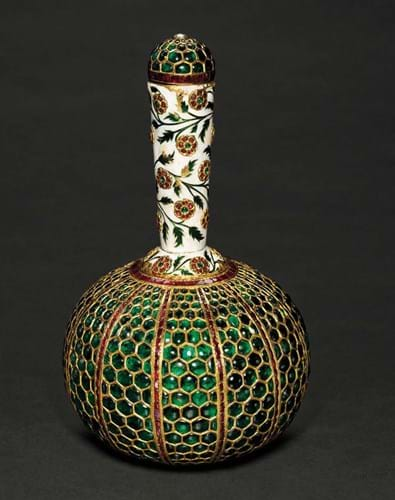
A late 17th or early 18th century Mughal enamelled and gem-set gold flask (surahi) - estimate £500,000-800,000 at Sotheby's.
This 9in (23cm) Mughal enamelled and gem-set gold flask (surahi) dates from the late 17th or early 18th century. Striking for its use of over 600 emeralds offset against a white enamel ground, it is closely related to the booty seized by Nader Shah from the Mughal treasury in 1739.
Formerly owned by a Nizam of Hyderabad, it was gifted to the family of the current owners in the 1930s and comes for sale at Sotheby’s with a guide of £500,000-800,000 on October 27.
Dealers
Runjeet Singh - A 19th century Gujarati shield with unusual hunting scenes
The decorative schema of this 19th century shield, offered by Runjeet Singh, places it within a group produced in Ahmedabad in Gujarat.
Within a floral border and repeating foliate pattern are various red-painted scenes on a black ground. In one, European men, recognisable from their pith helmets, hide in the brush and stalk a pair of tigers. In another, a fight is already under way, with one man held in the jaws of the animal.
To the reverse are patterns of gold concentric circles on a red ground. A similar example is in the Metropolitan Museum of Art which makes reference to other examples in its cataloguing. However, there is no other known example with such hunting scenes.
Oliver Forge and Brendan Lynch - A large 19th century Qajar steel vase with gold and silver inlay
This large Qajar steel vase bottle is unusual in that it displays an elaborate combination of metalworking techniques.
In shape and style of decoration it harks back to the Safavid period, the pear-shaped form having precedents in pottery and the chamfered foliate panels on the neck in architecture.
Forging of steel is a long tradition in Iran, where it was employed at first to produce weapons and was perfected during the Timurid and Safavid periods. By the Qajar period of the 19th century it survived in court arms and fashionable court objets d’art.
Mayfair dealership Forge & Lynch says this vase is almost identical to another it sold to the Metropolitan Museum of Art, New York, in 2018.
This example was in a private collection from 2007-20 and before that was in the London art trade from the 1980s.
Peter Finer - A 19th century Indian horse-headed khanjar and scabbard
The code for fashionable noble dress in northern India under the Mughals and their successors included the wearing of highly-decorated daggers.
Animal-headed daggers became popular early in the 17th century and were reserved for nobles of the highest rank. Though originally jadeite was the most popular material, more diverse materials were favoured later, as is evident on this 19th century khanjar and scabbard offered by dealer Peter Finer.
Possibly made in Jaipur, it features champlevé enamelling and stone incrustation in the kundun technique using cabochon garnets, emeralds and rock crystals.
The khanjar has a provenance to a private collection in the US.

